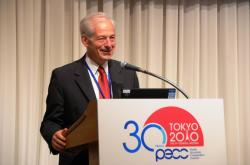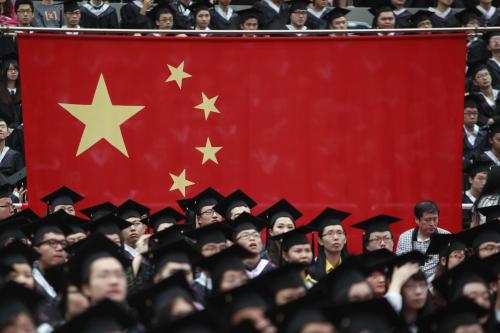China’s technological rise has led to anxiety in the United States over the possibility that China will dominate technologies of the future – but is there any merit to those concerns? Peter Petri, a nonresident senior fellow at Brookings and professor of International Finance at the Brandeis International Business School, joins David Dollar to provide an overview of technology competition between China and the United States.
Dollar and Petri are both contributors to a new book, China 2049, focused on how China may reform as it seeks to become the world’s next economic superpower.
Related content
China 2049: Economic Challenges of a Rising Global Power (Book)
China 2049: Economic challenges of a rising global power (Excerpt)
Is the ‘endless frontier’ at an end?
This transcript has been lightly edited for clarity.
DOLLAR: Hi, I’m David Dollar, host of the Brookings trade podcast Dollar & Sense. Today we’re going to talk about the technology competition between the U.S. and China. My guest is Peter Petri, a professor in the business school at Brandeis University and a non-resident senior fellow in our China Center at Brookings.
Peter and I have been involved in a book project together with economists from Brookings and Peking University. Our book, China 2049, is available from the Brookings Press and other sources. Peter wrote the chapter on technology competition and that’s going to be our topic today. So, Peter, welcome to the show.
PETRI: Thank you, David. It’s great to be on.
DOLLAR: There’s this growing anxiety in the United States about China’s technological rise. I sense almost a fear or anxiety that China is going to dominate the technologies of the future. So let’s start with the basic question: how do you assess China’s technology capacity, its innovation capacity?
PETRI: Well, first of all, I think the United States is well ahead and will be, by the estimates of most people who have written on this, for at least another decade or two. The end point of that will not be that the United States suddenly falls deeply behind China, but rather a more broad distribution of technology across the world. The United States is ahead because we have extraordinary universities, we have very good fundamental technologies, the connections between science and technology and business is very good, and we have a wonderful venture capital system that drives ideas into businesses. And I really think that this way of thinking about this as a race is just far too simplistic.
Technology already is global. For example, we have three vaccines that are very close to helping us with the COVID crisis. One of them is just down the street from us at Brandeis, at Moderna, a Cambridge company. Another one is at Oxford University in the UK, and the third one is at CanSino, which is a Chinese company, although it does have significant partnerships around the world. I frankly don’t care which one of these companies comes up with the vaccine first. And the fact that they are involved in a race with each other as companies, and indeed with another 50 or so companies around the world, is really what matters I think to all of us.
Dominating technology across the board is not really rational. We have too big a world, too complicated a set of ideas to deal with, and it will be enormously costly.
So having said that, let me say a couple of things about China and how it is catching up. It has already more R&D personnel than the United States has. They may not be as highly qualified, but it’s a very strong basis for research. They’re spending almost as much as we do. The World Intellectual Property Organization ranks the U.S. third by global indexes of technology and China fourteenth, but in the last five years that difference between the U.S. and China has halved. So they are spending a lot of money, education seems be the key driver of much of their progress, and in many areas they will become more competitive over time.
DOLLAR: So Peter, you make a convincing case that the U.S. still has a general lead and, as you say, probably will for one to two decades. But are there particular technologies where China is already at a par or superior to the U.S.? There’s particular concern about artificial intelligence, 5G, some key electronics technologies. So is China already ahead in some important areas?
PETRI: If you think about the U.S.’s lead in these basic close-to-science fields of technology, it does have a strong lead in semiconductor design and manufacturing, in basic pharmaceuticals, medical instruments, things like lasers. But China is very strong in applications – in the integration of lots of different technologies and complex systems, and especially in areas where the scale of its operations really matters.
So what does that mean? It means, for example, they are kind of the world’s leaders in online payments technology; the idea that you can use a code to buy yourself Coke from a machine that you’re standing next to. They are very good in solar energy and in manufacturing solar cells. They’re very good in the basic pharmaceutical ingredients, sort of fairly standard pharmaceutical ingredients for most drugs that are made in the United States and elsewhere. In AI, in image recognition, in smart cities, and of course in 5G – that we know about.
So the U.S. and China have strong advantages and these are complementary advantages so that U.S. tech companies like Qualcomm and Intel sell a lot, used to sell a lot, and still sell a lot to Chinese companies like Huawei and Alibaba. And the tech war is ultimately going to hurt both them and the Chinese companies that are under sanctions of various sorts.
DOLLAR: So while this is often portrayed in the press as competition between the U.S. and China, and actually you see this reflected in some of the security assessments in the United States, there’s also a lot of research collaboration that’s going on. Can you say something about the research collaboration and what are the advantages to having an open innovation system where Chinese and American companies and scientists – and economists too – work together?
PETRI: Yeah, and both you and I have of course worked for a very long time with many excellent researchers in China. But let me begin with the economics of this. Innovation, the activity of innovation, depends a lot on the scale of the innovative activity. How specialized people get and how deeply they can get into different aspects of innovation depends on the scale of the innovation activity and on access to ideas. That’s why in the United States, for example, you see clusters of researchers in Silicon Valley, in Boston, and other places where they take advantage of large scale and access to ideas from other researchers and scientists.
Now if you split the world in two, if we have Chinese technology and American technology, we essentially have the scale of innovation in each of those countries. We essentially have the world’s scale of innovation split into two parts. We also split the access to ideas into two parts – that is the Chinese will keep on and make sure that their ideas are kept as close to the Chinese sector as they possibly can, and the U.S. will obviously protect its stock of ideas. The effect of that, if you blow that up on the scale of worldwide innovation productivity, can be pretty significant. It will really cost the world a lot in terms of the new ideas we develop. So scientists and researchers kind of naturally gravitate toward communication and broadening their networks of ideas.
We had, I think, a remarkably deep cooperation between China and the United States until two or three years ago. It had to do with a community of basic scientists who travel to each other’s conferences. It had to do with advanced research projects in the U.S. and China, often funded by agencies from both the United States and China. It had to do with mutual investments by companies with a venture capital sector that sought out and funded ideas across the borders from both sides. It had to do, for example, with R&D sectors, which American companies established in China and Chinese companies established in the United States. More fundamentally – and this is the part that I’m closest to – it had to do with university faculty and students. We were very much engaged with each other in reading and in meeting through conferences.
David, you have followed this for a long time. My feeling is that a lot of this was very deep and you’ve seen this at the corporate level. What’s your sense of how deep that is and how much of that has survived?
DOLLAR: That’s a good question, Peter. I think it’s actually very deep, and it’s hard to get right up to the moment statistics, but my sense is quite a few American multinationals and of course European multinationals are expanding their research efforts in China because China is turning out so many scientific students per year. As you say, the quality of a university education is not up to the level of a Brandeis, for example, from the typical Chinese universities, but it’s a pretty solid system that’s turning out a large number of engineers and scientists so American companies are quietly expanding their research efforts. Obviously, the virus is going to affect that, the trade war, and it’s hard to get up to the moment statistics, but my sense is that its quietly expanding. Particularly, by the way, the U.S. restricting visas for people to come in, that’s actually increasing the incentive for American companies to expand their research laboratories in China and it’s definitely happening.
PETRI: That’s really good news. I must say from my viewpoint, sitting at a university and dealing with researchers around the world, things don’t look quite that optimistic. What I’m thinking about is that visits among researchers because of the visa problem you mentioned have really dropped off. I was reading that U.S. funding of researchers who might be involved in joint projects is under a great deal of pressure. As you probably know, the NIH just pulled funding from a very reputable U.S. project that was investigating viruses and the spread of diseases across the world which worked in a consortium which had the Wuhan Virology Institute as one of their members. This was mentioned in a press conference by President Trump and the NIH quickly pulled the funding from this project.
You hear some like 200 U.S. scholars are being investigated by the FBI for links to Chinese research organizations; some have been fired. So you hear a lot of things that are kind of scary for academics. My guess is that smart researchers will find ways to keep up. You mentioned this very interesting idea of having your corporate research organizations in China substitute for the interactions between companies that used to take place otherwise. So I’m sure smart researchers will keep up, but this is a kind of environment which we haven’t seen often in the U.S. and I think most academics feel that it’s harmful for science.
DOLLAR: Peter, you and I are obviously supportive of an open innovation system where people can travel, communicate, work together, et cetera. But let’s kind of look at the other side for a moment. This American hostility toward China, part of it is rooted in a sense that China does not have good intellectual property rights protection, that there is theft of U.S. technology, and what’s referred to as forced technology transfer. Some of these technologies have national security implications. So what do we do about some of those concerns? Is the U.S. approach actually addressing these concerns of intellectual property rights and national security technology issues?
PETRI: Intellectual property is very important for the U.S. for the reasons that we discussed a little earlier. The U.S. is a world leader, probably the world leader, in creating intellectual property so being compensated for that property is critical to the American economy. But if you look at the other side of this, Chinese royalty payments for intellectual property have been rising at about 20 percent a year for a couple of decades. I mean, this is a very sustained, substantial increase. China’s royalty payments for technology are now second only to the U.S, and a lot – somewhere between a quarter or a third – of Chinese royalty payments actually go to U.S. companies. So they are coming into this world in the way that one would like to see happen. That doesn’t mean that the Chinese obtain every piece of technology they use in a clean, purchased fashion.
One needs a bit of perspective there. Sort of every latecomer will use every means available to them and we have a lot of experience with Korea, with Japan, with Germany, and even in the U.S., in its early industrial revolution, of obtaining technology. They bought it, they invited investment from abroad, they re-engineered some things, and, yeah, at times they stole it.
I have by the way, but that’s another podcast, a great story about the beginnings of the U.S. industrial revolution in the textile industry right near us in Waltham, Massachusetts. But the key point is that these countries, including the U.S. and including Germany and so on, eventually move to the point – and quickly move to the point – where the technology they were generating domestically was at least as important as the technology that they were acquiring from abroad. And at that point, they became quite interested in protecting intellectual property. China is essentially near that point now.
So what that means is that I think if we apply the right sort of pressure on China they will be willing to improve their intellectual property regime, not just because we’re applying pressure, but because they themselves need it. My guess is if that had been our critical objective in starting this trade war we could have negotiated solutions that would have put us a long way towards solving the complaints that we had. In fact, even quite early in the trade war China made a series of concessions on intellectual property that indicated their interest in doing this. So I think this is an important issue, I think it’s an important issue for American policy, and I think it’s also a solvable issue, which, to be honest, I don’t think we’ve made a lot of progress on over the last couple of years.
DOLLAR: Peter, one of the hot button issues between the U.S. and China now is this company Huawei which is probably China’s most successful telecommunications company. The U.S. has really done some pretty extraordinary things to limit the sale from American companies, and even from foreign companies, to Huawei. How serious is a setback is this to Huawei? Is it going to be able to survive this campaign?
PETRI: It’s a pretty serious setback and they have been sort of whistling past the graveyard in talking about this. Their sales for the time being are rising because of domestic markets, but it is a pretty serious setback. I don’t think it’s a fatal one, not least because Huawei is so important in the Chinese economy, and in this Chinese vision of its own economy, that they will go a long way to try to keep this company alive.
One indicator of how successful Huawei has been in fighting this attack is how extensively – some people have even said desperately – the U.S. administration has ratcheted up the sanctions that it has been applying to Huawei. Huawei was at first surviving through re-engineering, through finding different markets. It kept roughly two-thirds of the foreign markets that it was targeting despite American pressure for other countries to withdraw their business, but it’s increasingly under pressure in very sensitive areas. As you know, only a couple of weeks ago the U.S. banned foreign companies from selling material to Huawei if they used any U.S. inputs – even very minimal U.S. inputs. That’s kind of a remarkable extraterritorial action on the part of the United States. It was aimed, by the way, at a Taiwanese semiconductor manufacturing company which is an important supplier of microchips designed by other companies. So the design might be Huawei’s own design, but TSMC makes it, but it could avoid doing business with Huawei in the future fearing American retribution.
Huawei faces two challenges. One of them is the android operating system, which is a Google operating system. Not that it can’t make one itself, but it won’t have access to the huge base of applications that are now already available with the Google system. So, that’s one important challenge. The more serious challenge is semiconductor manufacturing. It’s about one or two generations behind the frontier; the frontier being represented really by Taiwan. And people estimate that it may take as much as a decade for it to catch up.
One option for Huawei is an inexpensive but good enough product strategy: essentially selling, for example, 5G communication systems to developing countries, and even to developed countries but not in the most sensitive applications, that are not exactly at the frontier in technology but certainly very good at performing the main functions that they are intended to. And in the meantime, gradually catch up with the technology so that it can move back to the frontier when it finds technology.
So there are strategies there. There is a huge amount of support from the Chinese government and from the Chinese public – not just the government. So I suspect this is a company that not only will stay alive, but will be very strong again some years down the road even though the current damage is pretty significant.
DOLLAR: So U.S. policy toward Huawei is a good example of decoupling – this word that’s used by some of our policymakers and the defense community. There’s a move toward a larger decoupling of the U.S. and Chinese economies, and I think we’re far away from complete decoupling so it’s very speculative, but as an economist thinking about pretty much complete decoupling between the U.S. and Chinese economy this is going to hurt both economies. Do you have a sense of who might be hurting more by this?
PETRI: My guess is that at least in the immediate short-term – and by that I mean probably something like five years or so – China will be harmed more than the U.S. This comes back to the idea that as latecomer China developed its technology selectively. It took the areas where it was good and went very far in those areas, but it also had to rely on imported technologies from the U.S., from many countries around the world, from the UK, of course from Taiwan as we mentioned. This strategy, it’s a kind of economist strategy. You know, you specialize in the things you’re good at and then you fill in the gaps in the things that others are better at making. That strategy is kind of natural for latecomers in any industry or any technology, and that’s the strategy that’s really being challenged by the United States right now. Or it’s being undermined by the United States. I suspect China will react to it – it’s a very big country, very entrepreneurial country – by essentially a hunkering down and developing the technology eventually. But it’s just too strong, too vibrant an economy to fall apart because of these policies. It will be, once again, a global power in economics, technology and politics. It’s kind of part of the size and the rapidity of Chinese growth.
But we do see a decoupling. For example, I have done some research recently on new East Asian agreements in which Japan and Korea are forging agreements with Canada and Mexico – the former partners of the United States in the TPP. The UK may now attempt to join this agreement. So there is that set of agreements that’s happening excluding the United States. Another agreement, Regional Comprehensive Economic Partnership, is the nation agreement in which China is also a member. India used to be a member but has pulled out.
So you see these formations of economic blocs that exclude the United States, are more kind of narrowly focused on East Asia, strengthen the economic connections between China, Japan, Korea, and Southeast Asia – a large and formidable economic block. And all of that, coupled with the U.S.-China trade war, I think mean that a decade or so down the road these will be things that the United States will regret.
Now, whether we then go back and try to join these new economic formations or not I don’t know, but this cannot be good for the United States in the longer run, and I don’t think at the moment we are thinking about the longer run. Our politics and our decision making is too narrowly focused on November rather than on how this will affect America’s position and economy in a world in which the U.S. is playing a smaller part. It doesn’t mean that it’s not playing a very important part, but it’s a smaller part.
DOLLAR: Peter, let’s end on a positive note. So putting the U.S.-China competition aside for the moment and just thinking about what’s key to maintaining U.S. technological – I say leadership not necessarily in the sense of being the number one, but certainly we want to aspire to being a technology leader in the world. So what are some of the key things the U.S. should be doing to maintain that position?
PETRI: Thank you for getting us to a positive point in this conversation. This idea of America’s technological leadership in the sense that you defined is really important to me. I’m reminded of an op-ed that the president of MIT, Rafael Reif, wrote just at the beginning of the trade war – must have been two or three years ago. It was a short op-ed and it had a very simple message. Basically, it was saying that for god’s sake let’s focus on the U.S. technology ecosystem. Let’s invest in it, let’s make sure our universities stay in the lead, let’s make sure that our venture capital system is intact, that young companies, entrepreneurial companies, have an open road to develop big businesses.
The other point that he added is let’s sort of stay the magnet to world science that the United States has long been. I mean, it’s a magnet that attracts some of the best scientists, entrepreneurs, from around the world. In a way what he was saying is let’s trust our system, let’s trust the kind of openness and the kind of vibrancy that has got the United States to the point where it is today. And it doesn’t matter if the U.S. is smaller than China 10 years from now it its economy, it will still be the kind of intellectual center that most scientists will want to work in and where you can produce the kind of leading-edge innovations that we prize. That’s, I think, a hopeful note. And it’s not a hard formula, it’s a very natural one.
DOLLAR: That’s a really great note to end on. So, I’m David Dollar and you’ve been listening to Dollar & Sense. I’ve been talking to Peter Petri about technology competition between the U.S. and China, but more generally what the U.S. needs to do to maintain its position as technology leader in the world. So, thank you very much, Peter.
PETRI: Thanks, David.
DOLLAR: Thank you all for listening. We’ll be releasing new episodes of Dollar & Sense every other week, so if you haven’t already, make sure to subscribe on Apple Podcasts or wherever else you get your podcasts and stay tuned. Dollar & Sense is a part of the Brookings Podcast Network. It wouldn’t be possible without the support of Shawn Dhar, Anna Newby, Fred Dews, Chris McKenna, Gaston Reboredo, Camilo Ramirez, Emily Horne, and many more.
If you like the show, please make sure to rate it and leave us a review. Send any questions or episode suggestions to [email protected]. And, until next time, I’m David Dollar and this has been Dollar & Sense.





Commentary
PodcastThe US-China tech rivalry shapes the economic relationship
June 8, 2020